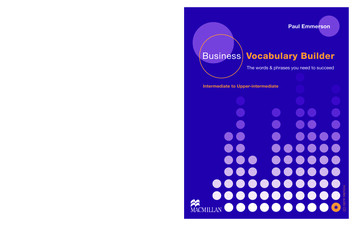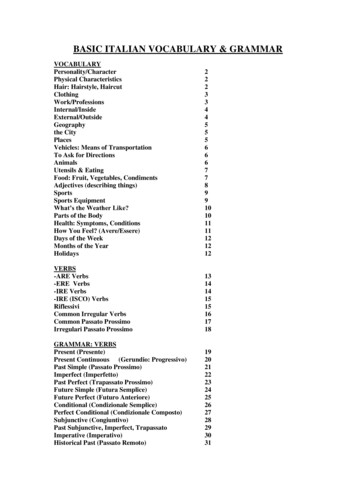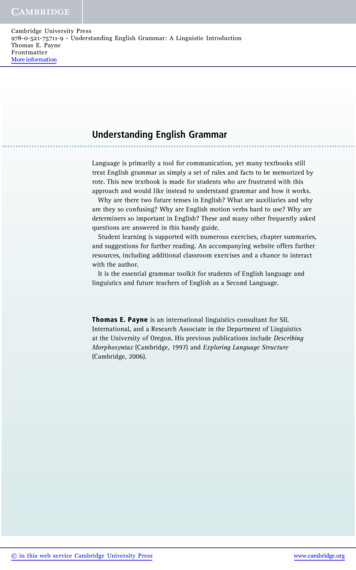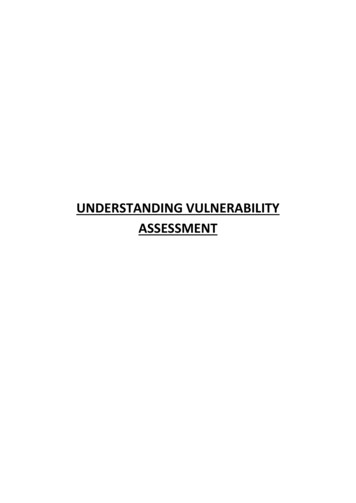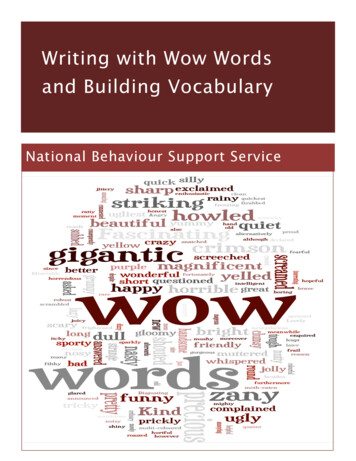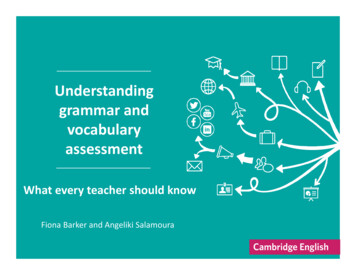
Transcription
Understandinggrammar andvocabularyassessmentWhat every teacher should knowFiona Barker and Angeliki Salamoura
Who are you?A. I’m a teacher.B. I’m a co‐ordinator/director of studies.C. I’m a learner.D. I’m a parent.
Why are you here?A. I need evidence of ContinuousProfessional Development.B. I want to earn an Open Badge.C. I want to know more about grammarand vocabulary assessment.D. Other
Digital Open ��badges
Understandinggrammar andvocabularyassessmentWhat every teacher should knowFiona Barker and Angeliki Salamoura
Our aim today keyquestions practicaltipsWhyam Itesting?How is mytestbenefitinglearners?Whoam Itesting?Howam Iscoring?Whatam Itesting?Howam Itesting?
Why is assessment ofvocabulary and grammar oneof the most commonforms of testing? Jojje
What am Itesting?
Which of the following are aspects ofgrammatical and lexical ability?A. Reciting rulesB. Ability to provide an accurate translationC. Ability to select a correct form from severaloptions on a multiple‐choice testD. Ability to use grammar and vocabularycorrectly while writing, speaking, readingor listeningE. All of the above
“Assessment of grammatical ability isnothing new. What has changed overtime is what teachers have chosen toassess under the title of ‘grammar’.”(Purpura 2004:3)
What is grammatical and lexical ability?recitingrulesPast ShutterstockNow
What is grammatical and lexical ability?recitingrulesPastNowprovide anaccuratetranslation
What is grammatical and lexical ability?recitingrulesPastselect a correctform fromseveral optionsNowprovide anaccuratetranslation
What is grammatical and lexical ability?recitingrulesPastselect a correctform fromseveral optionsNowprovide anaccuratetranslationuse grammar andvocabulary correctlywhile writing, speaking,reading or listening
Aspects of grammatical and lexical ncyregisterdiscourse tionscontexts of usefigurative use
Why assess grammar and vocabulary?
Why assess grammar and vocabulary?SPEAKING Generation of ideas(conceptualisation) Knowledge of grammar Knowledge of vocabulary Knowledge of sounds Articulation
Why assess grammar and vocabulary?READING Recognise and understand aword Understand the basic meaningof a phrase or sentence Understand implied meaning Understand informationacross sentences across a whole text across texts
Why assess grammar and vocabulary?READINGSPEAKING Recognise and understand aword Generation of ideas(conceptualisation) Understand the basic meaningof a phrase or sentence Knowledge of grammar Knowledge of vocabulary Understand implied meaning Knowledge of sounds Understand informationacross sentences across a whole text across texts Articulation
Careful of negative washback though!
How am Itesting?
Directly
IndirectlyWrite an answer in 120–180 words in an appropriate style.You have seen this announcement in an international magazine.MY FAVOURITE TEACHERTell us about a favourite teacher of yours and say what you rememberabout him or her. We will publish the most interesting article nextmonth. Write your article.
What type of response does each of thesetasks elicit?TASK ATASK BTASK C
Extended productionLimited productionSelectedresponse
How to evaluate test itemsStemMaria hasn’t seenher . 2 years.
How to evaluate test itemsStemMaria hasn’t seenher . 2 years.Responsea. duringb. sincec. tilld. for
How to evaluate test itemsStemMaria hasn’t seenher . 2 years.Responsea. duringb. sincec. tilld. forDistractors
How to evaluate test itemsStemMaria hasn’t seenher . 2 years.Responsea. duringb. sincec. tilld. forDistractorsKey
Evaluating a test itemHow well does this item test grammatical orlexical knowledge?A: Does your computer have a modem?B: Yes, .a. they haveb. it isc. it doesd. they do
Evaluating a test itemA: Does your computer have a modem?B: Yes, .a. they haveb. it isc. it doesd. they doAn improvement?Mike: Does your computer have a webcam?Jenny: Yes, it .a. isc. doesb. hasd. have
Tips 1: general guidelines
Tips 1: general guidelines No tricky questions
Tips 1: general guidelines No tricky questions Short stems only (maximum two lines)
Tips 1: general guidelines No tricky questions Short stems only (maximum two lines) Do not test language based on prescriptive grammaro ‘With whom did you go?’ vs. ‘Who did you go with?’
Tips 1: general guidelines No tricky questions Short stems only (maximum two lines) Do not test language based on prescriptive grammaro ‘With whom did you go?’ vs. ‘Who did you go with?’ Provide an example of a correctly answered item
Evaluating a test itemEmily: Do you want some bread?Josh: Yes, some.a. I loveb. I’d lovec. I’ll hated. I hate
Evaluating a test itemEmily: Do you want some bread?Josh: Yes, some.a. I loveb. I’d lovec. I’ll hated. I hateDo not test both grammar andvocabulary in the same question
Evaluating a test itemEmily: Do you want some bread?Josh: Yes, some.a. I loveb. I’d lovec. I’ll hated. I hateAn improvement?Emily: Do you want some bread?Josh: Yes, I some.a. could loveb. would lovec. will loved. am loving
Tips 2: keys and distractors
Tips 2: keys and distractors Include ONLY ONE key or correct answer
Tips 2: keys and distractors Include ONLY ONE key or correct answer Make all distractors equally plausible and ‘attractive’
Tips 2: keys and distractors Include ONLY ONE key or correct answer Make all distractors equally plausible and ‘attractive’ Do not use distractors that test something thestudents haven’t yet learned
Evaluating a test itemThe man to his 2:00 class.a. didn’t gob. don’t goc. didn’t wentd. don’t went
Evaluating a test itemThe man to his 2:00 class.a. didn’t gob. don’t goc. didn’t wentd. don’t wentDistractors should be UNGRAMMATICALwhen placed in the stem, but they should beGRAMMATICAL when considered in isolation
Evaluating a test itemThe man to his 2:00 class.a. didn’t gob. don’t goc. didn’t wentd. don’t wentAn improvement?The man didn’t to his 2:00 class.a. gob. goesc. wentd. gone
Tips 3: response format
Tips 3: response format Keys and distractors should be more or less of equallength
Tips 3: response format Keys and distractors should be more or less of equallength If all choices are of different length, order them fromshortest to longest or longest to shortest
Tips 3: response format Keys and distractors should be more or less of equallength If all choices are of different length, order them fromshortest to longest or longest to shortest Do not repeat the same word in the response if itcan be put in the stem, e.g.:Joan went to school .a. at 8 in the morningb. at 8 on the morningc. at 8 of the morningd. at 8 at the morning
How am Iscoring?
ScoringHow can you score the task types we discussed? a selected response item? True/False? Multiple Choice Question?
ScoringIncorrect answerCorrect answer 0 marks 1 mark
ScoringHow can you score the task types we discussed? a selected response item? a limited production item? Sentence Completion?
Scoring: limited production taskComplete the second sentence so that it has a similarmeaning to the first sentence, using the word given.You must use between two and five words, includingthe word given.Joan was in favour of visiting the museum.IDEAJoan thought it would beto the museum.
Scoring: limited production taskJoan was in favour of visiting the museum.IDEAJoan thought it would be a good idea to goto the museum.
Scoring: limited production taskJoan was in favour of visiting the museum.IDEAJoan thought it would be a good idea to goto the museum.Scalar scoring – 0 or 1 or 2 marks can be awarded
ScoringHow can you score the task types we discussed? a selected response item? a limited production item? an extended production task?
Writing assessment: language
Usefulresources
English Vocabulary Profile Free online resource based on research intovocabulary learning Shows which words and phrases – and individualmeanings of each word – are typically mastered atsix levels of the CEFR Valuable tool for decision‐making around what toteach and how to assess
http://vocabulary.englishprofile.org
English Grammar Profile
Summary
SummaryEnablingskills
SummaryEnablingskillsWashback
SummaryEnablingskillsWashbackRange oftasks &responses
t itemsRange oftasks &responses
SummaryEnablingskillsScoring& resourcesWell‐constructedtest itemsWashbackRange oftasks &responses
Furtherinformation
Teaching EnglishFree resources forteachersSample papers, handbooks,lesson plans and teacherguidesTeaching QualificationsFor new and experiencedteachersTeaching FrameworkHelps you assess whichstage you are at in yourprofessional developmentand work out where youwant to get to glishAbout our exams andteaching
www.cambridgeenglish.org/silt
Further informationUsing digital tools to enrich your learners’ vocabulary24 and 26 AprilUniversity of CambridgeCambridge English Language Assessment1 Hills Road, Cambridge, CB1 2EU, UKTel: 44 (0)1223 553997Fax: 44 (0)1223 553621Email: helpdesk@cambridgeenglish.orgKeep up to date with what’s new via theCambridge English Language Assessmentwebsite:www.cambridgeenglish.orgFor information on Cambridge Englishwebinars for teachers:www.cambridgeenglish.org/webinars
Understanding grammar and . Knowledge of grammar Knowledge of vocabulary Knowledge of sounds Articulation READING Recognise and understand a word
